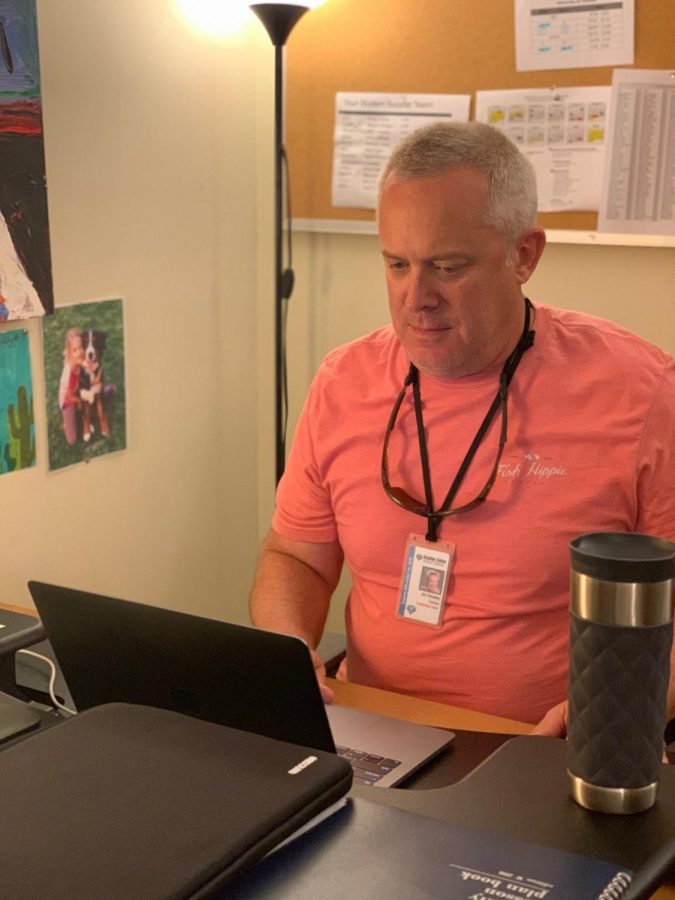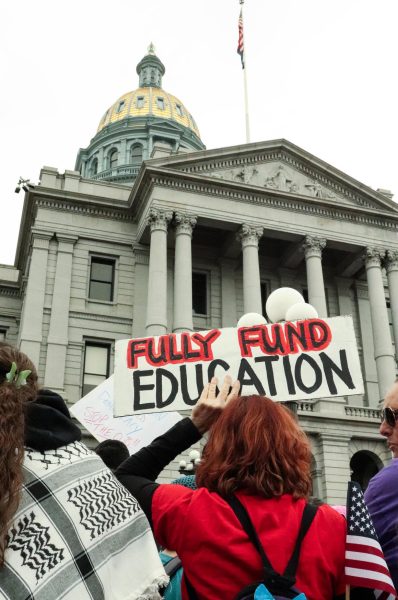Keeping the School Safe in the 21st Century
Jim Hensley working at his desk. Hensley, like many faculty, has concerns about the school’s safety.
America, in the 21st Century, is a frightening place. It’s a time when students don’t always feel safe in their schools because they fear getting shot more than doing poorly on a test. Considering how many school shootings have happened in recent years, it’s a reasonable fear.
While there have been lockdown drills and a few safety additions to prepare the student body, the preparations aren’t enough.
The school faces challenges providing the necessary updates and safety measures to protect everyone. Jim Hensley, a Language Arts teacher, felt that the school could be doing a lot more to keep students safe.
“We don’t want to take the time […] to ensure that kind of safety with this building, then build a new one. […] That’s what we have to do, we keep putting, as far as everything goes we keep putting a band-aid on a hemorrhage and we’re told that there’s no money, but yet how many millions have been flooded into this school?” said Hensley.
Elise Busse, a junior, agreed that the school doesn’t bother to do much in terms of safety.
“I’d say we’re not safe because […] the whole new LA hall, that’s all windows, and I’ve heard rumors that they’re supposed to be bulletproof, the windows, but honestly I feel like that’s fake. I don’t think the school would put that much effort into doing that stuff,” said Busse.
The school only placed a shatterproof film over the glass in the Language Arts hallway, according to Hensley.
Because the drills weren’t that frequent last school year, some people probably don’t understand the difference between lockdown and lockout situations. The names are very similar, but the scenarios are distinct. The main time that teachers go over these drills is at the very beginning of the school year, and most everyone hears it a few times in that first week.
Lockdown situations mean that there is a threat that someone could enter or has entered the school. Students should hide and all the lights go out so it seems like the school is empty.
Lockouts happen when a threat is in the vicinity, like a wild animal or a crime happening nearby, but students can still roam the school.
In addition, many students don’t even take these sorts of drills seriously and ignore them. That leaves people unprepared for an actual emergency.
Franzi Pflaum, a junior, talked about her thoughts on lockdown drills.
“I think that it does help, but from my past experience, like last year, we had a lockdown drill when there was a hostage at King Soopers and one of my friends, or two of my friends were locked into a dark closet and that actually caused them to be a little bit, like, they had some issues afterwards. So, they went to talk to some counselors because they were scared that actually someone was in the building and that someone was gonna hurt them, but it was actually that no one was there […], so we weren’t actually in danger, but the school made it seem like we were, so that was sort of an issue, but other than that I think they do prepare us, but also scare us,” she said.
It’s horrifying to hear that students were so misinformed on what had been happening that they experienced trauma.
Hensley expressed a similar frustration with the confusion between lockdown and lockout.
“I don’t like the lockdown/lockout, it’s the same language, and I just, I think it’s stupid. It’s stupid,” said Hensley. “To me if we’re in a lockout where we’re keeping people out of the building, call it shelter in place, or sheltering in place. Lockdown-lockout can be too confusing in the heat of the moment when something’s going on.”
Considering what happened with Pflaum’s friends, Hensley was right. The current system is too confusing, and whether a student confused a lockout for a lockdown or vice-versa, it’s dangerous.
If the school called a lockdown during any period, but especially a lunch period, many students have received mixed messages on what to do.
“I think it sort of mixed, confusing messages, they’ve told me that I should run to the nearest classroom but also that they are legally not supposed to open the door after they close it,” said Busse.
Hensley expressed what the teachers would do, or what the school told them to do, during a lockdown.
“Get to a classroom, so that should have been told to kids,” he said. “I kinda close my door at the last second, not so much with someone, like, coming at me or something but I try to hold on as long as I can to see that the halls are clear, and then I pull in and go into the procedure. I’m not saying it’s much longer, but within 30 seconds, you know if it’s not an immediate threat, I can stay aware for thirty seconds to ensure kids are out of the hall.”
The school is massive, with tons of entrances, and many don’t feel safe here, when there are so many gaps in the security.
Busse expressed her fears of being at the school.
“If there were to be one right now […] I wouldn’t feel safe being here right now. I would probably run to a classroom or something, but […] I’d be scared for my life still, you know?” she said.
A lockdown really could happen at any time, and while students are in the library having lunch or studying in an off period, they’re unprotected. In the hallways there’s a chance of a teacher letting people in, but that’s the best students can hope for.
On the other hand, Pflaum said that she felt rather safe in the school.
“I just feel like the school puts in so much effort into making school safe and they have strategies to keep us safe,” she said. “They did put in the new system where you have to put in your badge, and I mean that’s pretty good. […] I think Fairview’s doing pretty well. […] We’re in a good district, so we’re pretty safe.”
Hensley, though, felt like Busse. He made a few points on his own fears, and noticing the fears of his students while going through the drills.
“I went through a little bit of it the other day and I’m about to walk out to our spot tomorrow for the fire-drill, I kind of stopped because I just saw this sense of fear in my students […] talking about it, just think there’s a real fear, and I can’t say that I don’t feel it too, but there’s a real fear in this country that has been created by all this mass violence and […] we’re not doing the minimum to try to enforce this,” he said.
Hensley felt that students have the biggest role in keeping everyone safe.
“I think it really falls on you, the students, to look out for one another. To have compassion, and if they see something they need to flag it and they need to let an adult know. And, so what if they’re wrong? When that word gets out that there are more eyes and ears than people know about, that would help,” he said.
Hensley made a good point. If a student hears or notices anything alarming, even from a friend, they shouldn’t hesitate to say something. Everyone should take part in keeping others safe.
Busse felt that students, even if it’s important for them to try and help, won’t always see the danger coming.
“You’re gonna let people in when you’re unlocking the door if you have your ID and just to be courteous you’re gonna let them in too, and you’re not gonna let a creepy person in but you’re gonna let students, and there are school shootings that could be a student that does it,” said Busse. “Honestly, it’s sad but I don’t think as students we can do that much about it to prevent it.”
Anyone would hold the door open for others when they’re unlocking it. Almost no one is thinking that they’re going to shut it immediately so a shooter can’t come inside.
Hensley also thought that there was an issue with the student ID system.
“Teachers have to wear IDs, […] teachers are instructed to have their IDs on and displayed at all times, but students just have to have it, so they can get in the building. Why don’t students have to wear it? You know, how am I supposed to know if you’re a Fairview student? Maybe if I have you, but if I would have seen you, I’ve never had you as a student, I don’t know who you are, so, how do I determine that you’re a student here or you should be here?”
Most students would probably say that they don’t want to wear a lanyard all day long, but if they did it would show who belongs and who doesn’t, and increase the safety of the school.
Hensley said what he thought the school could do better as well.
“I think we need to have a forum and it really needs to be opened, district administration, our administration, parents, students, and teachers that wanna speak need to come together and start talking about some real stuff, and, not just oh yeah it’ll be fine, it’ll be fine, this it what we’re gonna do, we installed more cameras. I’ve never known a camera to stop a bullet. And if you have cameras inside a building when a shooting takes place, it’s already too late,” he said.
Busse concluded by talking about her fears in today’s America, and the inescapable thoughts she has in her head about escaping a shooter.
“I think it’s really sad that we have to grow up like this. […] It’s scary to know that I could walk here one day and, […] to think about my homework and the tests I have the next day, and see a best friend or someone get killed in front of me,” said Busse. “I think it’s a really depressing thing that most Americans have to think about.”
Your donation will support the student journalists of Fairview High School - CO. Your contribution will allow us to purchase equipment and cover our annual website hosting costs.

This is Anna’s second year writing for the Royal Banner. She enjoys writing, reading, and taking her dogs on walks.







